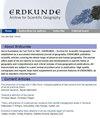中国生态系统服务规划:上海会走在前面吗?以上海市宝山区为例
IF 1.1
4区 社会学
Q3 GEOGRAPHY
引用次数: 4
摘要
生态系统服务是福祉和可持续城市发展的基本组成部分,在加强城市规划方面具有巨大潜力。最近,有几项研究使用ES方法评估了城市规划的环境绩效。为了加强这种科学与政策的整合,仍有必要在城市规划实践中进行生态系统评估,并收集关于设想的规划措施对世界各地城市环境中生态系统供应影响的经验证据。在本研究中,我们分析了中国新环境治理的现状,其目的是改变中国的土地利用政策,特别是绿色基础设施(GI)在城市规划和ES中的作用。我们以上海市宝山区总体规划为例,运用矩阵法对其在ES供应的视角下进行分析。我们确定了2035年生态网络规划中ES的供给,并建立了基于CICES v5.1和两次专家研讨会的评价框架。我们的方法采用了一个综合的ES初步评估,并评估了宝山区ES供应的后果,该方法适用于不同的城市地理位置。我们的评估结果表明,如果按计划实现,该地区将增加ES的整体供应,特别是在城市层面上在地理标志中发挥重要作用的调节和文化服务。一般来说,土地利用计划应包括建筑单元内的细粒度信息,以便更好地评估ES供应的空间结构本文章由计算机程序翻译,如有差异,请以英文原文为准。
China’s ecosystem services planning: will Shanghai lead the way? A case study from the Baoshan district (Shanghai)
Ecosystem services (ES) are a fundamental component of well-being and sustainable urban development with tremendous potential to enhance urban planning. Recently, several studies have evaluated the environmental performance of urban plans using the ES approach. To strengthen this science-policy integration, it is still necessary to perform ES assessments within the urban planning practice as well as to collect empirical evidence on the impacts of envisioned planning measures on the supply of ES in urban environments across the world. In this research, we analyzed the state-of-the-art of China’s new environmental governance, which aims to change China’s land use policy and particularly the role of Green Infrastructure (GI) regarding urban planning and ES. We focused on the Shanghai Baoshan district Master Plan as a case study, and analyzed it under the lenses of the supply of ES using the matrix approach. We ascertained the supply of ES as delineated in the ecological network plan for 2035, and developed an evaluation framework based on CICES v5.1 and two expert workshops. Our approach used an integrated preliminary ES-assessment, and evaluated the consequences for the supply of ES in Baoshan district, which is adaptable to varying urban geographies. The results of our assessment show that, if realized as planned, the district will increase the overall supply of ES, especially regulating and cultural services, that play an important role within GI on the urban level. In general, the land use plans should include fine-grained information within building blocks to allow for even better assessing of the spatial structure of the supply of ES
求助全文
通过发布文献求助,成功后即可免费获取论文全文。
去求助
来源期刊

Erdkunde
地学-自然地理
CiteScore
2.00
自引率
7.10%
发文量
17
审稿时长
>12 weeks
期刊介绍:
Since foundation by Carl Troll in 1947, ''ERDKUNDE – Archive for Scientific Geography'' has established as a successful international journal of geography. ERDKUNDE publishes scientific articles covering the whole range of physical and human geography. The journal offers state of the art reports on recent trends and developments in specific fields of geography and comprehensive and critical reviews of new geographical publications. All manuscripts are subject to a peer-review procedure prior to publication. High quality cartography and regular large sized supplements are prominent features of ERDKUNDE, as well as standard coloured figures.
 求助内容:
求助内容: 应助结果提醒方式:
应助结果提醒方式:


